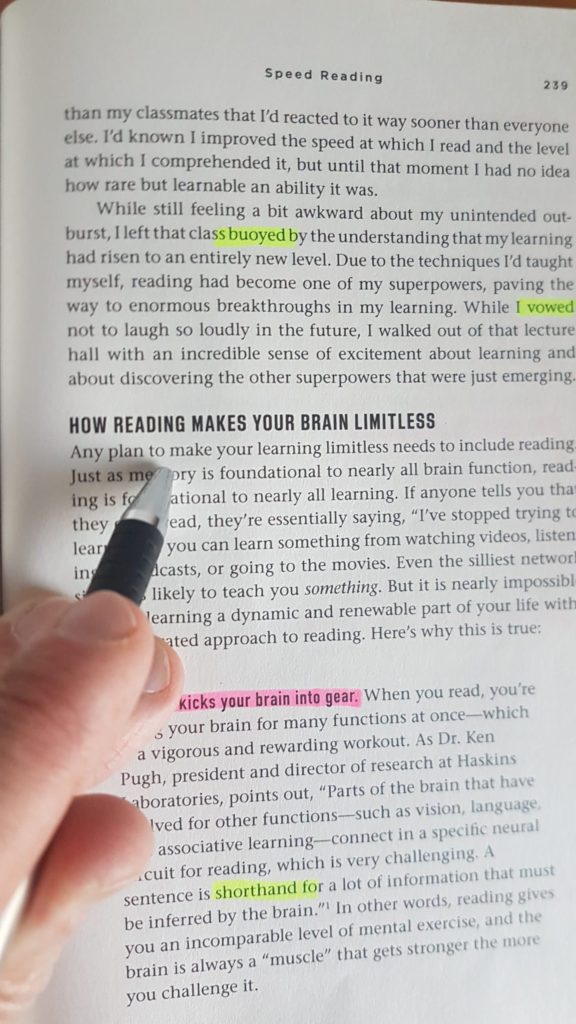5 Top Spead Reading exercises how to read faster
Why would you increase your reading speed?
Since you are interested in this article, you are probably also a fan of good books. Wouldn’t it be handy if you could read a book at twice the speed? With the speed reading exercises presented here, you’ll be able to do it!
‘Yes, but then I won’t understand any of the content!’ you will now say. And yet, science agrees that reading speed can be increased without decreasing text comprehension.
There are limits, of course. When you get there, text comprehension wanes. And, the nature of the texts also determines whether speed reading is useful.
But, I think the comparison with driving a car is very apt here. You can drive both fast and slow, and adjust this according to the traffic situation.
If you can read both fast and slow, you will be able to speed up or slow down depending on the difficulty of the text.
And that’s why I want to increase my current maximum reading speed, and maybe you do too.
With the speed reading exercises presented here, you can significantly increase your reading speed.
But first, there’s the question of how fast you can read at all right now.
What is the average reading speed?
According to the definition, speed reading is reading texts quickly without losing comprehension of the text.
Reading speed changes as you grow up. For example, in sixth grade, a person can read about 177 words per minute. A 9th grade child reads about 219 words per minute. By 12th grade, it’s 261 words. Students get to about 300 words per minute and adults in general read 250 words per minute.
Of course, practice, type of text and education level all play a role in reading speed.
Science says that reading speed can be increased to 800 to 1500 words per minute without significantly affecting text comprehension (Source: Wikipedia Germany).
The world record for speed reading is said to be held by Anne Jones, who is said to have read the book Harry Potter and the Deathly Hallows in a time of 47 minutes, resulting in a reading rate of 4,251 words per minute (Source: Wikipedia Germany).
These are values that are not easy to accomplish and certainly not achievable for everyone, but doubling your own reading speed would be, you will admit, a very worthwhile goal.
So, let’s get started!
Measuring your own reading speed
Logically, in order to improve, you first need to know your current state, i.e. your current reading speed.
I suggest you do it the way I read it in the book ‘Limitless’ by Jim Kwik (This book is not only about speed reading, but mainly about learning and thinking in general. I have attached the link to the book for you below).
You need an alarm clock (cell phone timer), a book or a longer text that is not too easy and not too difficult to read, and a pencil.
You set the timer for two minutes and read your text as you usually read. After two minutes, use the pencil to mark the part of the text you got to.
You could now count all the words you read and divide the number by two. Then you would have the number of words per minute. In the book already mentioned, a slightly faster way of counting is presented.
Count the words in three complete lines. Divide the number by three. Now you have the number of words per line.
Then count the number of lines in your text. But you must count only those lines that go at least to the middle of the page.
Now multiply the number of lines by the number of words per line you counted. Now you have calculated the number of words you read in two minutes.
So you have to do the final calculation step and divide your number by two. This gives your reading speed in words per minute.
And do not get frustrated if you’re now below average (I, for example, was at 240 words per minute when I first measured it. And for further reassurance, I can tell you that Jim Kwik assumes an average between 150 and 250).
What is slowing down your reading?
- Lack of attention (I am sure you remember moments when you were tired trying to read and comprehend something).
- Regression: This is the, sometimes unconscious, jumping back of the eyes while reading.
- Subvocalization: The internal speaking along while reading (Useful at the beginning of learning to read and with difficult texts, but a hindrance thereafter!)
- Fixations: The lingering of the eye on a word.
Exercises for speed reading
1. Use a pacer (e.g. index finger or similar)
Materials needed: text, timer, index finger or pencil
This exercise helps against the regression mentioned above. Just run your index finger under the line you want to read and resist the temptation to jump back.
Please, if you do not try any other exercise, do this one!
Of all speed reading exercises tghis is my favorite one because it is easy to implement and shows immediate success.
According to Jim Kwik, this exercise results in an increase of between 25 and 100%.
I got right up to 415 words per minute the first time I read with this speed-reading exercise and felt I had a very good understanding of the text.
So again, find an easy to moderately difficult text.
Set the timer back to two minutes and start reading. How you calculate your reading speed, I have already described above.

2. The 4-minutes Turbo Exercise
Materials needed: text, timer, index finger or pencil
For this speed reading exercise we again use the index finger or a pen as a pacer.
Again, take a text that you have not read in the previous exercise and set the timer to four minutes.
After reading for four minutes, mark the passage in the book with a pencil. This is now your FINISH LINE for the next exercise.
You now set the timer to three minutes and try to “read’ the text in three minutes and reach the finish line in three minutes. Text comprehension is now secondary (not important). This is all about speed!
Afterwards you increase the whole thing to two and then even to one minute. Please do not skip a line. Once again – it is not about text comprehension!
And now comes the learning effect:
Read, now starting from your finish line, a new section of text for two minutes and determine your new reading speed.
3. Reduce your fixations
Materials needed: pencil, ruler and text
When reading, it is enough to skim most of the words, since they are already familiar to you. You should not fixate them, at least if you want to read faster. Now let’s do another exercise!
Divide your text into three equal columns. Now jump from vertical line to vertical line. That means you make only three jumps per line instead of the usual six or so.
4. ‘Speech is silver silence is gold’
This exercise serves to stop your talking along in your head or your mumbling along.
It is is easy to do and you do not need any additional material.
It goes like this: Read a text while counting aloud 1..2..3..1..2..3..1..2..3……
It feels strange at the beginning and is difficult as well.
5. ‘Uncovering-exercise’
Materials needed: Blank sheet of paper, text
Now you take the sheet of paper and an easy-to-read text.
First, you cover the text completely with the sheet of paper. Then you push the sheet down for a short moment so that you can see the top line. You do this until you have captured the top line. You immediately put the sheet back up again.
Then you go down line by line in the same way.
The goal of this exercise is to capture the entire sentence in a snapshot, if possible, by increasing your range of vision.
More Speed Reading Tips
In addition to the specific speed reading exercises, it is also useful to try the following, more general, tips:
- As you increase your vocabulary, you will also improve your speed, since familiar words can logically be grasped more quickly.
- Ask yourself questions about the text. This will increase your attention. For example, you might ask, ‘how’, ‘why’, and ‘when can I use what I’m about to read?’
- Set yourself a time limit for reading. This also sharpens your perception.
- Take regular breaks. Use Francesco Cirillo’s Pomodoro Technique, which states that the optimal duration of a task is 25 minutes, followed by a five-minute break. This is because we are good at remembering things that occurred at the beginning of a task, presentation, or the like. We are just as good at remembering things that happened toward the end of that task, presentation, or activity.
Consequently, you can make good use of this effect in reading as well.
I hope you were able to learn some new speed reading exercises through this article. Why don’t you try them out, preferably immediately or within 48 hours? Because, if you extend the time further, the probability that you will implement what you have learned, decreases very significantly.
Feel free to tell me how you did
And here is, as announced, the link to Limitless by Jim Kwik – a highly recommended book about learning and thinking!
One more thing that might be of interest to you. If you wanna read some more good personal development books, I recommend my article on my top 7 self-help books.
To your success,
Michael

